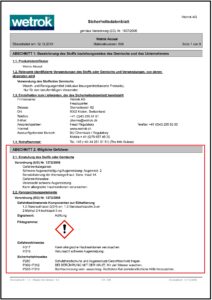8 reasons why you should read the safety data sheet
28.10.2020
Let’s be honest: reading safety data sheets is tiresome, laborious and time-consuming. In this post, we list eight reasons why it’s very necessary for your health and safety, as well as that of your colleagues and neighbours.
1. Identify hazards
Before a mountaineer starts climbing a mountain, they research the potential dangers in the respective area – as they should. The same goes for working with chemicals: whether your boss or your colleagues, who have been working with the product for a long time, think it’s necessary or not – you need to know what’s what! When it comes to chemicals, this means: you need to know which hazardous substances are in the product. For example: acids, alkalis, phosphates, nitrates, sulphates or flammable ingredients. You also need to know the threshold values: a low concentration of a hazardous substance is not always dangerous in everyday use.
→ see section 3 of the safety data sheet
However, there are also substances that are very dangerous on their own, but are neutralised in combination with other substances. For example, fluorine and sodium are hazardous substances – even though they can be found in almost all toothpastes. Why? When both substances are used together, they neutralise each other and have a positive effect: strengthening the tooth enamel. For this reason, you should pay attention to the classification of the mixture and the labelling elements:
→ see section 2 of the safety data sheet

2. Take suitable protective measures (PPE)
The safety data sheet informs you which personal protective equipment (PPE) you need to use while working with the chemical. For example, you may need to wear suitable hand protection (protective gloves) or eye protection (protective goggles).
The safety data sheet also functions as a checklist for you, the employee. It can be used to check whether your employer has provided all the necessary (and mandatory) protective equipment, as specified on the safety data sheet.
→ see section 8 of the safety data sheet
3. Protect pregnant women and trainees
Pregnant women and young people (i.e. trainees) are at increased risk of harm on contact with certain chemicals. In other words: they should not work with these chemicals. You can only protect vulnerable groups if you are familiar with the legal regulations.
→ see section 15 of the safety data sheet
4. Introduce first-aid measures
What should I do if someone has accidentally drunk or swallowed a chemical? Once again, it’s very important you read the safety data sheet. This is because inducing vomiting is not always advisable, as this can cause hazardous substances to enter the airways and oesophagus, causing even more damage. If someone has swallowed a corrosive substance, vomiting will cause the oesophagus to be burned yet again by the substance on its way back up. In such an event, you should always consult the safety data sheet. It will inform you whether vomiting should be induced, or whether other measures should be taken instead.
→ see section 4 of the safety data sheet
5. Provide medical professionals with the right information
In the event of an accident, it’s important to provide medical professionals with as much information as possible about the chemical involved. Only then can they administer the right medical treatment. In such an event, please take the safety data sheet with you when you see a doctor.
→ entire safety data sheet (especially sections 2 and 3)
6. Ensure correct storage & safe transport
When it comes to transport and storage of chemicals, it is important that certain safety measures are in place. The safety data sheet informs you whether a chemical must be transported as hazardous goods, or whether collection trays must be installed in the storage location.
→ see sections 7 and 14 of the safety data sheet
7. Know what to do in the event of a fire
In the event of a fire, the safety data sheet is an important reference tool in extinguishing the fire. For example, it tells you the flammability and suitable extinguishing agents.
→ see section 5 of the safety data sheet
8. Protect the environment
Many chemicals are subject to strict disposal requirements. For example, certain chemicals should never enter standing or moving bodies of water. The safety data sheet informs how the chemical can be correctly disposed of.
→ see section 13 of the safety data sheet
Conclusion: Know the risks to prevent the risks
The safety data sheet protects your health and safety by answering two basic questions about working with chemicals: What are the risks and how can I prevent them?
Download safety data sheets now
We provide all the necessary safety data sheets for Wetrok cleaning products on the Wetrok website:
![]()
We immediately update our safety data sheets when recommendations change, and publish them in a variety of languages. In case of any questions about safety data sheets, the Wetrok team for product safety and regulatory affairs will be happy to help: chemie@wetrok.ch
